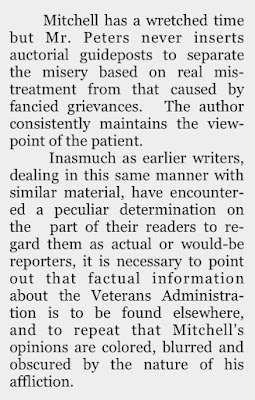 |
| TOP ROW: The World Next Door, New York : Farrar, Straus, 1949 with author, Fritz Peters. BOTTOM ROW: Author, Mary Jane Ward and her novel, The Snake Pit, New York : Random House, 1946. |
Reviews of The World Next Door often referenced and compared it to Mary Jane Ward's landmark The Snake Pit from 1946 due to its focus on the patient experience within a psychiatric hospital. While some reviewers suggested that it held its own against the standard-bearer of psychiatric novels, others thought that it was in fact superior. When The New York Times Book Review published its review of The World Next Door penned by Ms. Ward it became the talk of the literary world.3, 4 It was much discussed because it was so out of step with the consensus view of the work. In order to understand the source of this scathing review, one must first try to understand Mary Jane Ward's experience publishing her own novel based on her stay in a psychiatric hospital.
 |
| Excerpt from Nightmare Revisited, Mary Jane Ward's review of Fritz Peters' The World Next Door.4 |
For all of the issues that Ward hoped to change in psychiatric care, she saw those doctors and staff providing treatment as generally good people trying to do good work. Peters' novel provides insight into the male experience, and the experience at a military hospital in the post World War II years in particular—a very different situation than the one Ward described.
Unlike, Ms. Ward, Fritz Peters appeared to become an overnight success—blurbed by major authors and also drawing attention to the shortcomings of psychiatric care at that time. The World Next Door, based on Peters' own experience, sees its protagonist, David Mitchell admit during the course of his treatment that he had a previous homosexual experience. Because patient records were available to staff of all levels on the ward, it became common knowledge. This knowledge was used against him by ward staff, culminating in a sexual assault. But because the word of a psychiatric patient can't be trusted, his accusation wasn't believed by the doctors.
Did Mary Jane Ward simply not find plausible the idea of staff behaving in this way? Or did Ward find Peters' characterization of hospital staff as not only unfeeling but as potentially sexually predatory a threat to all of the work that she had done in recent years to improve the patient experience? Was this simply a case of sour grapes for Peters' writing in a genre that she had dominated? Or was it more about the relative ease with which the literary establishment welcomed Peters' work after Ward had struggled for years to get published? Was his relative ease of being published down to sexism? One thing is for sure, Peters certainly struck a nerve.
Note
This post is meant to highlight an anomalous review of Fritz Peters' The World Next Door, while giving the reader a sense of how the book was generally received and what Peters' literary future was perceived to hold. Mary Jane Ward's The Snake Pit is an extraordinary work and remains a favorite of early Cold War era psychiatric novels. Both authors and their novels, which offer different perspectives on a common theme, are well worth a read.
1 Bixbi, G. (1980, Win.). Blurbs: Welty on Fritz Peters. Eudora Welty Newsletter, 4(1), p.2-6
2 Babcock, F. (1950, Jan. 1). Among the Authors. Chicago Daily Tribune, p.F6.
3 Kilgallen, D. (1949, Nov. 3). Voice of Broadway. Olean Times-Herald (Olean, NY), p.18.
4 Ward, M. J. (1949, Sept. 18). Nightmare Revisited. New York Times Book Review, p.6.%20Henri%20Cartier-Bresson%20%201935%20gelatin%20silver%20print.png)